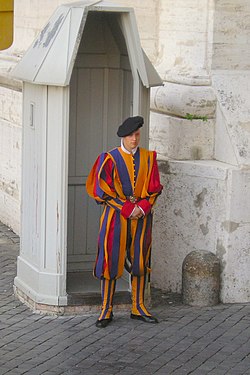

The following outline is provided as an overview of and introduction to Vatican City:
Contents
- General reference
- Geography of Vatican City
- Location of Vatican City
- Environment of Vatican City
- Regions of Vatican City
- Demography of Vatican City
- Government and politics of Vatican City
- Branches of the government of Vatican City
- Foreign relations of Vatican City
- Law and order in Vatican City
- Military in Vatican City
- Local government in Vatican City
- History of Vatican City
- Culture of Vatican City
- Art in Vatican City
- Sports in Vatican City
- Economy and infrastructure of Vatican City
- Education in Vatican City
- See also
- References
- External links
Vatican City – an ecclesiastical or sacerdotal-monarchical [1] state, being the sovereign territory of the Holy See and ruled by the Bishop of Rome—the Pope, the leader of the worldwide Catholic Church. The territory of this landlocked sovereign city-state consists of a walled enclave within the city of Rome, Italy. It has an area of approximately 49 hectares (121 acres) [a] and a population of about 825. [b] This makes Vatican City the smallest independent state in the world by both area and population.












